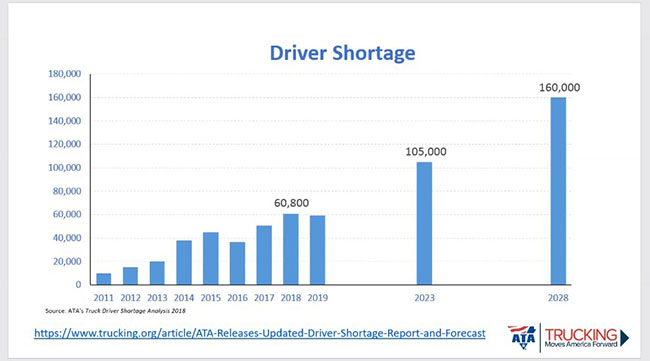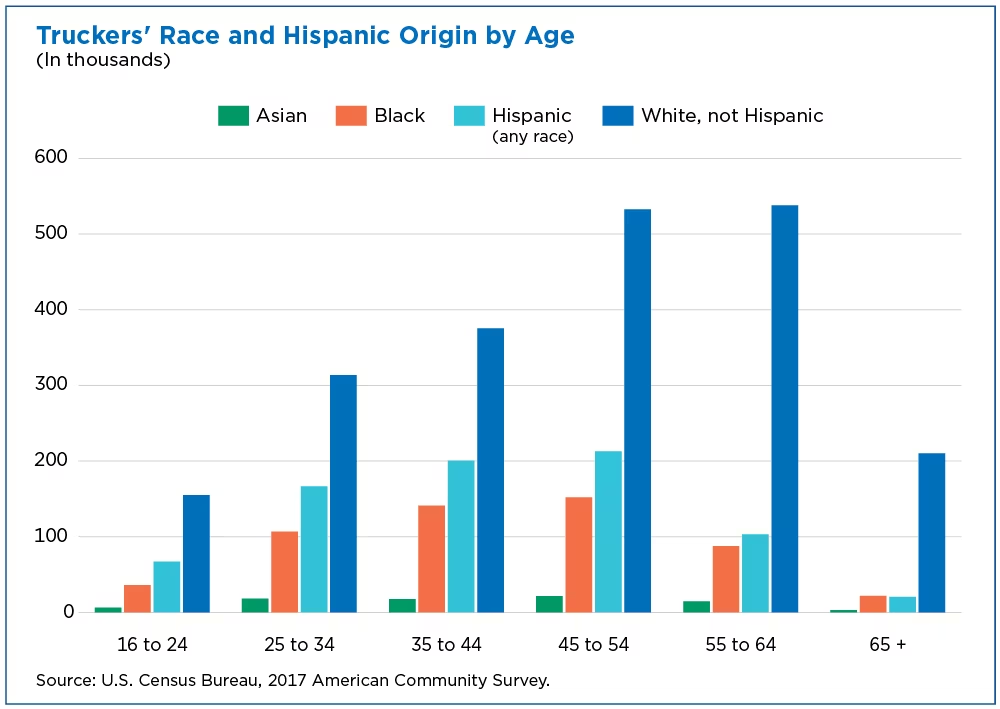Online sources estimate truck driver turnover rate in transportation at 89-90%. According to the Upper Great Plains Transportation Institute, the average cost of replacing a single truck driver is over $8,000. In some cases, it can be as high as $20,000.
The first documented shortfall of Class 8 tractor-trailer drivers by the American Trucking Associations (ATA) dates back to 2005. Ever since, industry professionals have engaged in ongoing disputes regarding the question: “Is there a truck driver shortage?” Regardless of one's stance, the fact remains: the job market is booming, with vacancies for semi-truck drivers available across the United States. Let us explore the potential causes of this issue and identify solutions to mitigate it.
In 2023, the ATA’s Chief Economist, Bob Costello, reported that the driver shortage in the trucking industry dropped to 60,000, compared to 78,000 in 2022. This temporary improvement can be attributed to a simple cause: the bankruptcy of Yellow Corp, which flooded the market with tens of thousands of CDL holders seeking employment. Still, it appears the issue will persist, and by 2030 it’s estimated to reach 160,000, unless government institutions, non-government organizations and transportation players find an efficient way to fill the gap.

Truck Driver Shortage Analysis, https://www.trucking.org/
The problem behind the US truck driver shortage is multidimensional and emerges from a combination of demographic, economic, regulatory as well as industry-specific factors. Here’s some demographic trucking data as a starter to help us see the bigger picture.
The majority of statistics providers (ATA, U.S. Census Bureau, Zippia) indicate that there’re 3.5 million professional truck drivers employed in the economy. The prevailing ethnicity is White followed by Hispanic, Black and Asian. The female portion of overall commercial driver’s licenses (CDLs) holders varies from 5% to 12% depending on the online source you’d like to rely on (The New York Times, Zippia or Women In Trucking Association). The average age of a truck driver is 47 years old and 72% of the employed are 40+ or older.
Let’s face it: trucking is indeed the backbone of the economy, because almost all businesses in the US require truck drivers. It leads to an extreme demand that the current supply of drivers cannot accommodate. And importantly, the image of trucking greatly suffers from a negative public perception, that’s why it’s not currently possible to bring in new hires at scale.

Trucker’s Race Breakdown, https://www.census.gov/
Workforce Demographics
Considering the shared demographics info, it’s obvious that the workforce is aging while new blood is unable to saturate the market. Although truck driving is one of the few jobs that pays a decent wage for high school graduates, by the federal law they have to wait until 21 to get a commercial driver’s license. In 2020 the FMCSA proposed a Safe Driver Apprenticeship Pilot Program that would allow drivers between 18 and 20 to operate commercial vehicles in interstate commerce after mandatory probation period. The Program hasn’t yet been implemented, however, the initiative seems rather promising.
Underrepresented Groups and Minorities
Another important reason for the CDL driver shortage is underrepresented groups and minorities. The face of modern-day trucking is white male over 40. With women accounting for 46.8% of the labor force it seems realistic to attract a greater female share into truck driving, especially if we take into account that historically agriculture, construction and military were considered as purely male occupations.

Elevated Turnover and Higher Than Normal Job Switching
Leaders of the Owner-Operator Independent Drivers Association (OOIDA) who represent the interests of independent truckers, stress that the real matter is high driver turnover rather than the lack of truck drivers. And it’s mostly long-haul carriers they refer to as the source of this problem. To better understand turnover and navigate it you may want to review our article on the matter. In brief, it all comes down to rough trucking lifestyle, inadequate compensation, insufficient recognition, and strict government regulations in the sphere of freight transportation.
Outdated Recruitment Strategies and Techniques
Though not so self-evident, outdated recruitment strategies and techniques contribute to the trucking shortage. According to the U.S. Department of Transportation, as of April 2023, there were over 750,000 active US motor carriers, which makes it a stiff competition game.
Over the years Leadgamp has developed a number of successful approaches in attracting, hiring and retaining CDL Class A drivers. We keep staying tuned to emerging trends and would be glad to bring our expertise to your recruitment table. Feel free to Get In Touch.
Technological Advancements and Automation Fears
Paradoxically, technology and automation apart from solving problems, may breed fears that aren’t totally unwarranted. Concerns about job security arising from the potential for autonomous trucks and advanced technology may discourage individuals from pursuing careers in trucking, adding up to the lack of truck drivers. Outsiders may find it funny, but the anxiety about being displaced by engineering achievements may seem as a deterring risk even to those who drive semi trucks at the present time.

Digital Literacy Requirements
As the industry is adopting more technology for logistics, safety, compliance, navigation, and communication, the requirement for digital literacy increases in parallel. This may potentially deter CDL holders who are less comfortable with such technologies and force them pursue a different career.
Inadequate Legal Protection
Truck driver’s job goes far beyond just driving. They often face legal challenges related to accidents, cargo disputes, intricate web of regulations and compliance issues. For example, inefficiencies in logistics, such as poor route planning and load matching can lead to delivery delays and damaged goods. The situation is exacerbated with inadequate legal support and protection, which leaves drivers vulnerable to significant financial, legal, and professional risks.
Supply Chain Disruptions
Transportation is not immune to the supply chain disruptions that are harming other economic sectors. For instance, critical service parts are scarce, which forces drivers off the road while they wait for repairs. Or trailer manufacturers can’t fulfill orders fast enough to meet industry demand. As a result, we get limited growth of capacity at a time when it is sorely needed.

The question how to solve the truck driver shortage remains open nowadays and demands involvement of stakeholders across all levels: government, society, industry, trade unions and business owners.
It is paramount to instill and promote a positive trucking image and extend acknowledgement to truckers beyond the days of the National Truck Driver Appreciation Week.
Professional Driver Training Programs
Freight carriers are more than welcome to establish professional driver training programs to satisfy their hiring needs. A great example of truck driver shortage solution in action is Walmart. They made significant policy changes in 2022 and introduced a private fleet development program that allows drivers to earn their CDL license over the course of 12 weeks.
Inclusive Recruitment Strategies
Implementing inclusive recruitment strategies can attract individuals from various underrepresented groups and backgrounds. Organizations that promote inclusivity and diversity within the trucking industry include:
Enhanced Retention
Again, we dedicated an extensive article on how to decrease truck driver turnover. We won’t reinvent a wheel by suggesting such truck driver shortage solutions as establishing a driver council, performing management ride-alongs, creating a consistent driver onboarding experience and cultivating a positive work environment. This is something almost everyone in the industry is well aware of, yet not so many players can boast of having implemented them.

Less-Than-Truckload Shipping and Collaboration With Other Carriers
Full-truckload (FTL) and over-the-road (OTR) shipping impose a lot of time on the road and that rough trucking lifestyle. That’s where we can observe the highest turnover rate and insatiable driver shortage. Opposed to them, less-than-truckload (LTL) drivers come home every night and enjoy a healthy work-life balance.
Decentralized warehouses (hub and spoke distribution model as an example), route optimization software, collaboration with other carriers and load sharing are just some ways that can help us achieve more short-haul routes that would appeal to drivers.
The truck driver shortage in the US presents a complex challenge, woven from demographic shifts, technological fears, high turnover rate, and outdated recruitment strategies. Yet, the pathway to alleviating this shortage lies in multifaceted solutions: embracing technology while mitigating its fears, legal reforms to protect drivers, inclusive and innovative recruitment strategies, and fostering a positive image of the trucking profession. As we look to the future, it's clear that collaborative efforts from all stakeholders are essential to ensure the sustainability and growth of the trucking industry.




